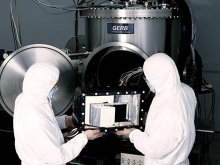
Arianne 5, carrying the MSG3 satellite lifting off from the Guiana Space Centre in Kourou, French Guiana at 21:36 GMT, July 5th'.

The latest satellite in the Meteosat Second Generation (MSG) series has been successfully launched.
The latest satellite in the Meteosat Second Generation (MSG) series has been successfully launched from French Guiana, lifting off at 21:36 GMT on Thursday July 5th. As well as carrying instrumentation vital for European weather forecasting, the satellite also carries the third in the series of Geostationary Earth Radiation Budget (GERB) instruments, an initiative led by Professor John Harries of the Space and Atmospheric Physics Group at Imperial College. From a fixed position over the equator and Greenwich meridian, GERB makes measurements of the balance between incoming energy from the Sun and outgoing energy leaving the Earth every fifteen minutes throughout the day. These unique observations have provided new insights into the impact of rapidly changing atmospheric phenomena like clouds and aerosols on the Earth’s energy budget and have been used to improve the computer models we use to make weather and climate predictions. Starting from the first GERB in 2004, the mission is planned to extend until at least 2016. This will provide a multi-year continuous dataset which we can use to further test and improve our understanding of our climate system.

News item photo: Credits: ESA/VNES/Arianespace/Optique Video du CSG
Article text (excluding photos or graphics) available under an Attribution-NonCommercial-ShareAlike Creative Commons license.
Photos and graphics subject to third party copyright used with permission or © Imperial College London.
Reporter
Caroline Jackson
Department of Physics

Contact details
Email: press.office@imperial.ac.uk
Show all stories by this author




Leave a comment
Your comment may be published, displaying your name as you provide it, unless you request otherwise. Your contact details will never be published.